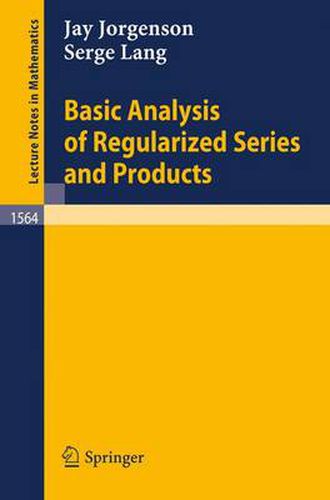Readings Newsletter
Become a Readings Member to make your shopping experience even easier.
Sign in or sign up for free!
You’re not far away from qualifying for FREE standard shipping within Australia
You’ve qualified for FREE standard shipping within Australia
The cart is loading…






This title is printed to order. This book may have been self-published. If so, we cannot guarantee the quality of the content. In the main most books will have gone through the editing process however some may not. We therefore suggest that you be aware of this before ordering this book. If in doubt check either the author or publisher’s details as we are unable to accept any returns unless they are faulty. Please contact us if you have any questions.
Analytic number theory and part of the spectral theory of operators (differential, pseudo-differential, elliptic, etc.) are being merged under a more general analytic theory of regularized products of certain sequences satisfying a few basic axioms. The most basic examples consist of the sequence of natural numbers, the sequence of zeros with positive imaginary part of the Riemann zeta function, and the sequence of eigenvalues, say of a positive Laplacian on a compact, or certain cases of non-compact, manifold. The resulting theory is applicable to ergodic theory and dynamical systems; to the zeta and L-functions of number theory or representation theory and modular forms; Selberg-like zeta functions; and to the theory of regularized determinants familiar in physics and other parts of mathematics. Aside from presenting a systematic account of widely scattered results, the theory also provides new results. One part of the theory deals with complex analytic properties, and another part deals with Fourier analysis. Typical examples are given. This LNM provides basic results which are and will be used in further papers, starting with a general formulation of Cramer’s theorem and explicit formulas. The exposition is self-contained (except for far-reaching examples), requiring only standard knowledge of analysis.
$9.00 standard shipping within Australia
FREE standard shipping within Australia for orders over $100.00
Express & International shipping calculated at checkout
This title is printed to order. This book may have been self-published. If so, we cannot guarantee the quality of the content. In the main most books will have gone through the editing process however some may not. We therefore suggest that you be aware of this before ordering this book. If in doubt check either the author or publisher’s details as we are unable to accept any returns unless they are faulty. Please contact us if you have any questions.
Analytic number theory and part of the spectral theory of operators (differential, pseudo-differential, elliptic, etc.) are being merged under a more general analytic theory of regularized products of certain sequences satisfying a few basic axioms. The most basic examples consist of the sequence of natural numbers, the sequence of zeros with positive imaginary part of the Riemann zeta function, and the sequence of eigenvalues, say of a positive Laplacian on a compact, or certain cases of non-compact, manifold. The resulting theory is applicable to ergodic theory and dynamical systems; to the zeta and L-functions of number theory or representation theory and modular forms; Selberg-like zeta functions; and to the theory of regularized determinants familiar in physics and other parts of mathematics. Aside from presenting a systematic account of widely scattered results, the theory also provides new results. One part of the theory deals with complex analytic properties, and another part deals with Fourier analysis. Typical examples are given. This LNM provides basic results which are and will be used in further papers, starting with a general formulation of Cramer’s theorem and explicit formulas. The exposition is self-contained (except for far-reaching examples), requiring only standard knowledge of analysis.